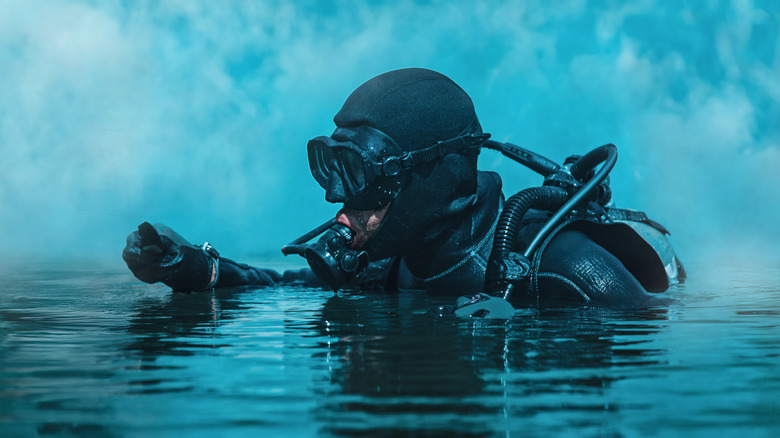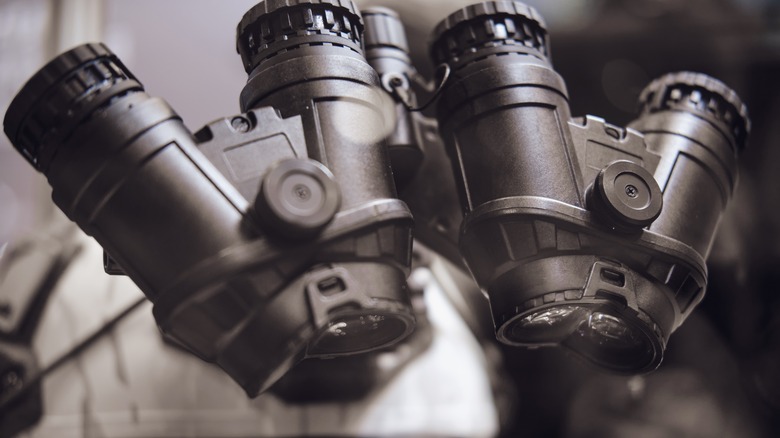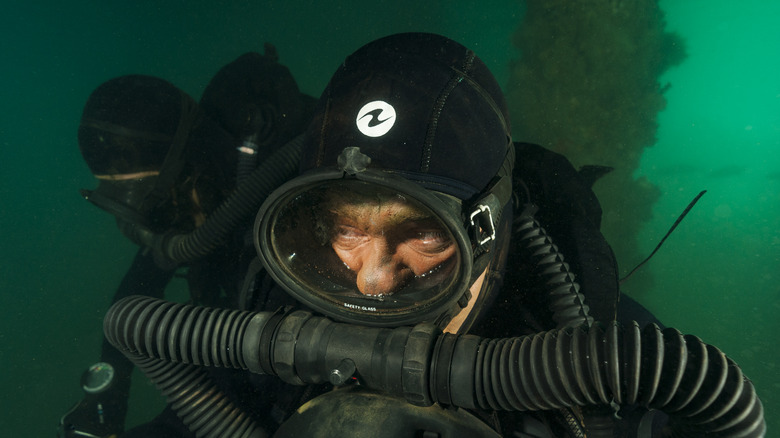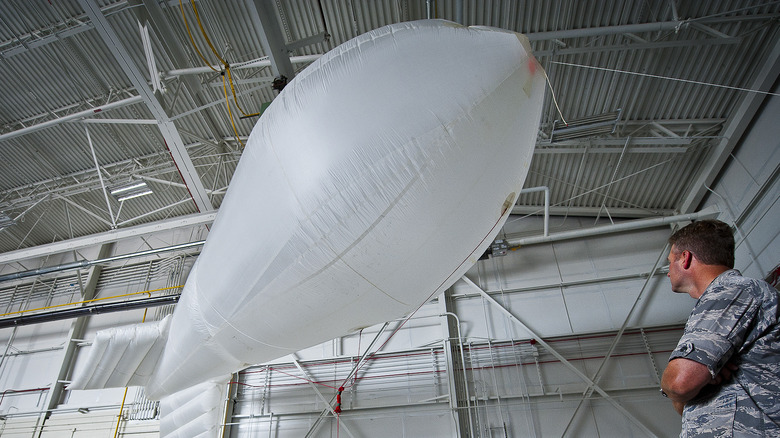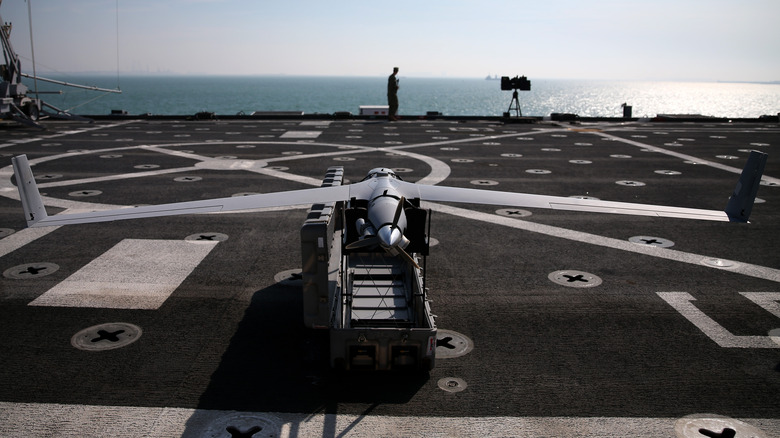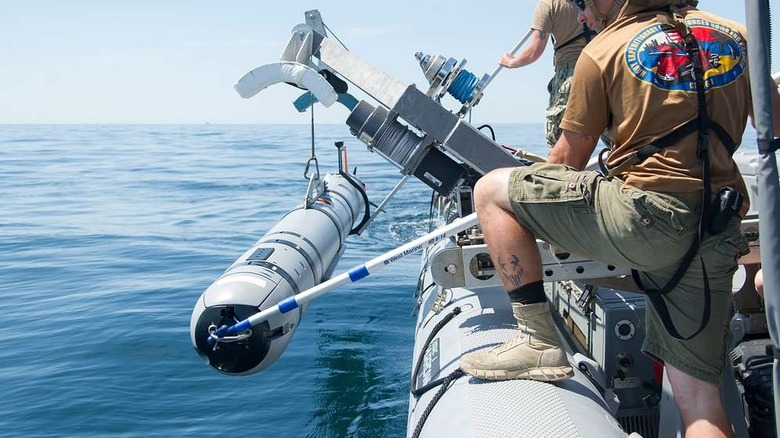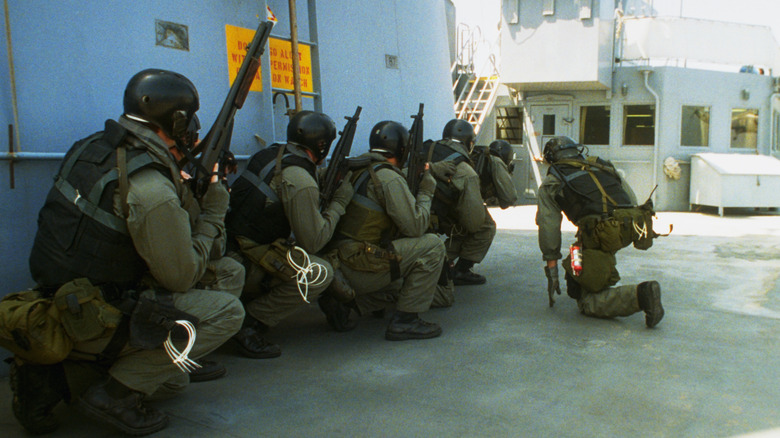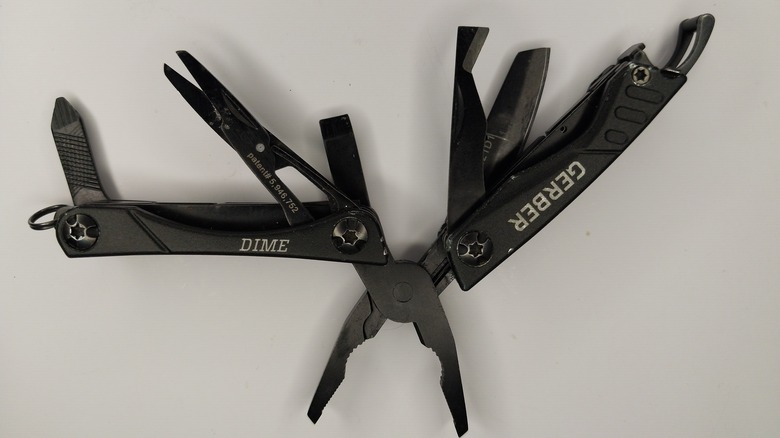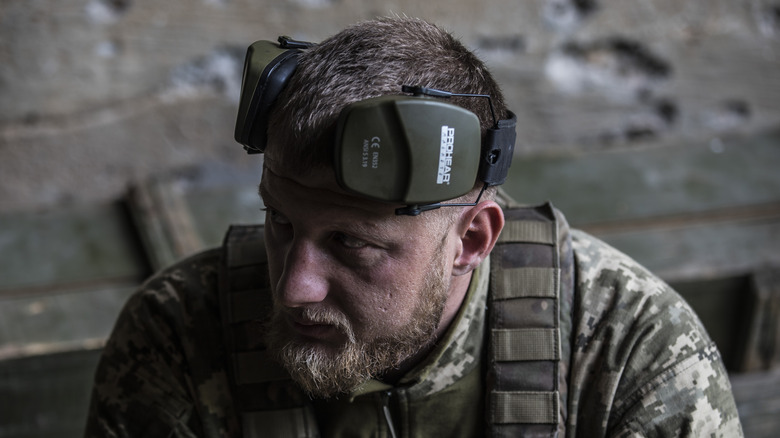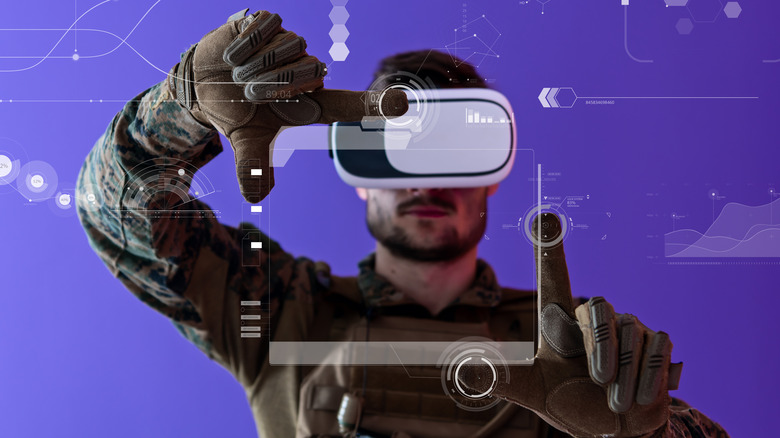9 Of The Coolest Pieces Of Gear Used By Navy SEALs
The global war on terrorism shone a spotlight on America's special operations. Upon the invasions of Iraq and Afghanistan in the early 2000s, pitched battles and daring rescue operations made their way into news stories. A public tangentially aware of organizations like the Navy SEALs, Delta Force, Army Rangers, and others became enamored with the derring-do of America's elite warriors.
The revelation of the awe-inspiring high-tech gear that operators carried into battle was a fascinating outcome of special operations stepping into the limelight. Some of these advanced technologies are so extraordinary their technical specificities are restricted from the public, adding to the mystique and intrigue surrounding these organizations.
Of all the special operations forces in the United States military, perhaps none are as famous as the Navy SEALS. Originating as a maritime command force after the Second World War, the SEAL commandos are trained to operate in any environment. The name SEAL is an acronym for Sea, Air, and Land, representing a willingness to undertake the riskiest missions in the most adversarial environments.
As a premier special operations unit, SEALs enjoy a healthy budget and significant leeway in developing and deploying some high-speed equipment. Join us as we examine some of the coolest gear U.S. Navy SEALs have used in combat deployments worldwide.
L-3 Ground Panoramic Night Vision Goggles (GPNVG)
American military forces have been using night vision for decades. The starlight scope was an early light-amplifying device that aided troops in the low-light jungle environments of the Vietnam War. The enormous advantage of seeing in the dark — combined with the prohibitively expensive and sometimes sensitive equipment — has kept the United States and its allies masters of the night on the battlefield.
The 2012 film "Zero Dark Thirty" depicts Operation Neptune Spear — the mission carried out by SEAL Team 6 to kill Osama Bin Laden in 2011. Viewers can see the SEAL operators equipped with an otherworldly NVG with four tubular stalks that flip down over their eyes. From their point of view, the world is bathed in green light while the forces in the Abbottabad compound remain blinded in the dark.
The L-3 Warrior Systems Ground Panoramic Night Vision Goggle (GPNVG) is a technological marvel, a significant leap from previous-generation binocular night vision goggles. Unlike its predecessors, which offer a 40-degree view, the GPNVG provides an impressive 120-degree view. This 27-ounce unit harnesses the minimal light in its environment, amplifies it, converts it to an electrical signal, and presents it to the user's eyes in a collection of green images. Each unit currently costs up to $50,000, reportedly as much as $65,000 back in 2011, when the Bin Laden raid occurred.
While the L-3 GPNVGs are among the top night vision devices available today, the Department of Defense is not resting on its laurels. It continues to push the boundaries of technology, launching the ENVision program in 2021.
Drager Closed-Circuit Oxygen Rebreather
The maritime invasions of World War II presented the United States with a problem. The Navy needed to accurately surveil enemy beaches to identify and mark undersea obstacles in preparation for amphibious landings. Naval underwater demolition teams were tasked with this challenging mission. Upon completing that war, these teams evolved into SEAL teams, and their mission expanded.
Surreptitiously invading an enemy harbor to sabotage equipment or ingressing unfriendly beaches is a crucial component of a SEAL skill set. Prospective Navy SEALs undergo a demanding training regimen to become combat diving experts. But what good is all that knowledge if a telltale trial of bubbles makes the enemy aware of your presence?
With a typical self-contained underwater breathing apparatus (SCUBA), divers inhale an oxygen mixture from a tank and exhale through regulators. The bubbles from the exhalation then float to the surface, potentially alerting observers. The Draeger rebreather rig uses a canister of sodium hydroxide to scrub carbon dioxide from a diver's exhalations and replace it with oxygen, which the diver can inhale.
Rebreather rigs like the Draeger are available for civilian use, but the cons outweigh the pros. Commandos like the SEALs use them to aid their stealthy missions, but the pro of not leaving behind a trail of bubbles, while essential in combat, does not outweigh the increased risk. In a 2013 study, Dr. Andrew Fock estimated that the risk of death while operating a rebreather is five to 10 times greater than that of a typical SCUBA apparatus.
Fulton Skyhook
SEALs are known for their willingness to go anywhere and do anything. It is the nature of special operations. But the Fulton Skyhook may be the most insane piece of gear ever devised by the military.
Most of the time, the air component of the SEAL ethos accounts for helicopter rides or parachuting. Modern SEALs receive training in high altitude, low opening (HALO), and low altitude, low opening (LALO) jumping to insert into a target. But what if a SEAL or other special operator wanted to extract in a hurry? That's where the Fulton Skyhook comes in.
On May 3, 1966, Captain Gerald T. Lyrve bobbed in the ocean. He was awaiting the first test of the Fulton Recovery System. An inflated balloon floated above him, and a line ran from the balloon to a harness around his torso. As Lyrve waited, an airplane appeared on the horizon. Flying overhead, the plane swept past the balloon, a specially designed hook capturing the line and yanking Lyrve into the air. Towing the man in the wake behind the aircraft, the crew slowly reeled him to safety in the plane's cargo bay.
The CIA, Air Force, and Navy all trained on the Fulton Skyhook system. It's a jarring but effective way to retrieve gear, personnel, or even an enemy prisoner. The military abandoned the Skyhook's use for personnel retrieval after a 10th Special Forces Group soldier died in an accident in 1982. However, it still retains operability for the retrieval of non-living cargo.
[Featured image by U.S. Air Force photo/Tech. Sgt. Samuel King Jr. via Wikimedia Commons | Cropped and scaled | Public Domain]
ScanEagle drone
Drone technology is changing warfare. Evidence of that fact is plentiful in videos of the recent conflict in Ukraine. The average infantryman can suddenly access relatively inexpensive, lightweight, flying machines with weapons attached to them. Some drones used by the military, like the MQ-4C Triton are the size of small planes, while others, like the Marine Corps' new Rogue 1 are essentially handheld kamikaze missiles.
As a front-line special operations unit, the SEAL teams often get their hands on slick tech early. One piece of equipment was the ScanEagle, an unmanned Aerial Vehicle (UAV) capable of being launched from the battlefield and loitering over an area for up to 15 hours. The ScanEagle's sensors and camera allow ground troops to capture live reconnaissance of their situation before being captured with a skyhook recovery system for reuse.
SEALs reportedly used the ScanEagle during the 2009 rescue of Captain Phillips, captain of the container ship Maersk Alabama, when he was taken hostage by pirates off the coast of Somalia.
The Marine Corps contracted Boeing in 2004 to develop a force reconnaissance craft to protect troops in Iraq. Since then, the ScanEagle has logged nearly half a million combat flight hours. Admittedly getting a little long in the tooth, the ScanEagle uses over-the-counter technology and cameras, so even if one crashes or is shot down, the enemy won't get any great benefit from access to it. Conventional and special operations have deployed the ScanEagle to gain situational awareness and keep combat troops safe and effective.
Submarine drones
Drones aren't just for the air. While America's longest war took place in landlocked Afghanistan, China's pacific expansion has Navy special operations focusing back on the water.
SEAL teams have been using submarine drones for dangerous missions like mine-clearing since as far back as the early 2000s. The attack on the USS Cole in Yemen in October of 2000 is a perfect example of the Navy's concern over harbor safety. Once, the Navy would fly in a team of divers to secure any harbor at which a Navy ship would dock. But then it started to use REMUS drones, which looked like torpedoes, to clear areas of danger.
The SEALs' latest efforts in underwater drone technology include combining the mission of the Seal Delivery Vehicle (SDV) teams with autonomous drone technology. A mini-sub known as the Proteus can carry up to six SEALs into an operation while liaising with and directing unmanned drones to gather intelligence or secure the area. The Proteus can also operate autonomously at depths of up to 200 feet with a range of 700 nautical miles.
Like drones that take to the sky, submarine drone technology presents incredible military and civilian opportunities for exploration and experimentation. Over 95% of the ocean remains unexplored, but as military technologies like the Proteus become available to the civilian world, that number could start coming down.
[Featured image by Mass Communication Specialist 2nd Class Charles Oki via Wikimedia Commons | Cropped and scaled | Public Domain]
Grapnel Gun
Picture this: A compressed bang, and a projectile is launched from the barrel of a compact pistol. It's not just any projectile, but one that trails 100 feet of Kevlar rope. As it flies, three prongs extend outward, deftly catching the railing above and providing the shooter with a means of access. This isn't a scene from a Batman movie but a real-life scenario where SEALs, aboard a small rubber boat, keep pace with an oil tanker at night.
Maritime interdiction is one of the SEALs primary missions, and not every bad guy relishes the idea of getting boarded by elite warfighters. Gaining entry to an enormous ship underway is incredibly dangerous, as evidenced by the loss of two SEALs trying to do just that in January 2024.
The Department of Defense charged contractor Batelle with developing a grapnel launcher that would function well in SEAL teams. The result was a compressed-air powered (SEALs can hook it right into their SCUBA gear) 20-pound pistol that can shoot a golf ball at supersonic speeds. Woe to the unfortunate pirate standing by the railing when that hook comes flying aboard. The techniques and tactics SEALs use when boarding ships are a carefully guarded secret, but the grapnel gun is a critical component of that mission.
Gerber Multi-Tool
It is common knowledge that multi-tools make a great choice for hiking and camping, but did you know they come in handy when taking down internationally renowned terrorists? In his memoir, "No Easy Day," author and former Navy SEAL Matt Bissonette, who participated in the mission to take down Bin Laden, reported that each SEAL on the team was issued a Gerber multi-tool. Though it's unclear exactly which Gerber the team got, it was reported to have a knife blade, screwdriver, scissors, and a can opener — maybe for celebratory drinks afterward?
Many multi-tool companies devote some lines of product to military use. The Gerber MP600 Pro Scout is designed to be opened with one hand just in case the other one is busy operating. Gerber's 07400 model includes a blasting-cap crimper — something you typically don't need for your weekend at the campground.
Multi-tools, regardless of brand, are space-saving and innovative products. SEALs have an unusual amount of leeway to decide what gear to carry into the field, but many include a multi-tool in their kit. Some retired commandos have even gone into a business developing knives and other equipment they wish they had downrange.
Bone Phones
The ability to broadcast messages over great distances, a scientific achievement once thought impossible, revolutionized communication. Like most technologies, nations immediately applied Marconi's miraculous invention to military situations.
For special operations teams like the SEALs, who often operate behind enemy lines and close to hostile forces, a chattering radio could mean the difference between life and death. Even the tinny buzz of an earphone can catch the attention of a sentry in a deathly quiet environment. The solution? Bone conduction hearing equipment transmits vibrations into the bones of the skull to relay messages.
Popularly known as bone phones, the communication technology sits outside the ear and transmits sound to the cochlea in the inner ear. The result is a transmission that only the wearer of the bone phone can hear. No crackling radio from an impatient commander to alert the enemy to your presence. But what about transmitting?
SEALs wear throat mics to complement their bone-conduction headphones. Throat microphones attach to the throat near the larynx, picking up vibrations for transmission. Speakers can communicate more quietly with a throat mic. They also have the advantage of not interfering with facial gear such as dive masks or helmets and cutting down on ambient noise — critical for loud situations like combat.
Into the Future
The latest in military technology remains a secret to most civilians. The first stealth plane, the F-117 Nighthawk was in the American arsenal for seven years before it became public knowledge. We still probably wouldn't know about the stealth helicopter technology used in the Bin Laden raid if not for the unfortunate downing of one of the birds.
By the time military technology becomes declassified or accidentally publicized, its a safe bet that something even cooler and more advanced is lurking in the laboratories of DARPA or in the equipment lockers of elite operators like the SEAL teams.
One good thing about a nation that spends so much money on its military research is that these technologies often trickle down to civilian use after a time. You may not taking a Fulton Skyhook to your next appointment, but affordable night vision or civilian bone conduction headphones are a pretty cool consolation prize.
